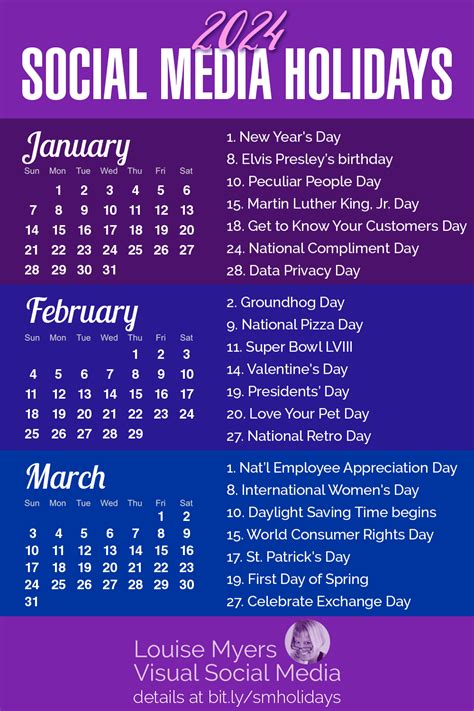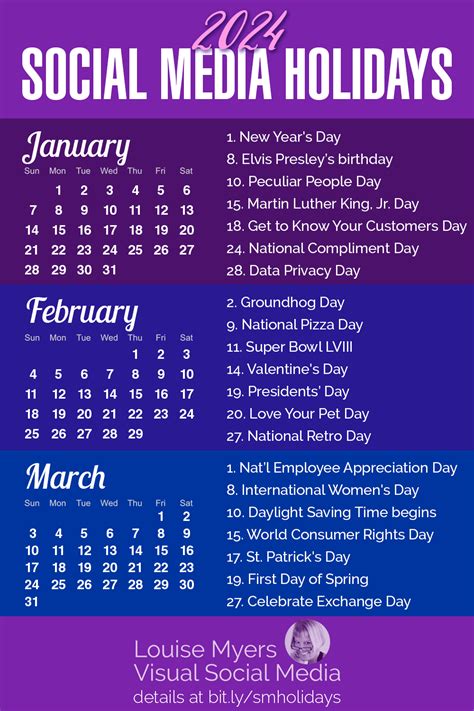Learn the dos and don’ts of planning your 2024 social media holiday calendar, including understanding your audience, researching trending holidays, and creating engaging visuals.In today’s digital age, having a strong social media presence is crucial for any brand or business. As we look ahead to 2024, it’s essential to start planning your social media holiday calendar now. From understanding your audience to creating engaging visuals, there are many important considerations to keep in mind. In this blog post, we’ll explore the dos and don’ts of planning your 2024 social media holiday calendar. We’ll discuss the importance of understanding your audience, researching trending holidays, choosing relevant platforms, balancing promotional content, creating engaging visuals, and evaluating and adapting strategies. By following these guidelines, you can ensure that your social media content remains relevant and engaging throughout the year, ultimately leading to increased brand awareness and customer engagement. So, let’s dive in and start planning for a successful social media holiday calendar in 2024!
Understanding Your Audience
When it comes to planning your 2024 social media holiday calendar, it is crucial to start by understanding your audience. This involves gathering data and insights about their demographics, interests, and behaviors. By doing so, you can tailor your holiday content to resonate with them and drive engagement.
One of the dos of understanding your audience is to use analytics tools to gather information about their age, location, gender, and online activity. This will give you a comprehensive view of who your audience is and what they respond to. Additionally, you should research their interests and preferences to create holiday content that appeals to them.
On the other hand, one of the don’ts is to make assumptions about your audience without data to back it up. It’s important to rely on actual insights rather than guesses or stereotypes. Avoid creating holiday content that doesn’t resonate with your audience, as it can lead to disengagement and a negative impact on your social media presence.
By understanding your audience and their preferences, you can effectively plan and execute a successful 2024 social media holiday calendar that resonates with them and drives engagement.
Researching Trending Holidays
When planning your 2024 social media holiday calendar, it’s important to stay up to date with the latest trending holidays. One of the best ways to do this is by researching and identifying holidays that are gaining traction and popularity among your target audience.
Utilize online resources and tools to identify upcoming holidays and trends that are relevant to your industry or niche. Look for holidays that resonate with your brand and values, and align with your marketing goals. Consider using tools such as Google Trends, social media analytics, and industry reports to uncover popular holidays and themes that are relevant to your audience.
Once you have identified trending holidays that align with your brand, create a calendar or schedule to plan and organize your content and promotional activities around these holidays. This will help you stay ahead of upcoming trends and ensure that your social media content is timely and relevant to your audience.
Choosing Relevant Platforms
When it comes to choosing the relevant platforms for your social media marketing efforts, it’s important to consider where your target audience spends their time online. Conduct research to determine which social media platforms are most popular among your demographic. For example, if you are targeting a younger audience, platforms like TikTok and Snapchat might be more relevant, whereas if you are targeting professionals, LinkedIn would be a better fit.
Additionally, think about the type of content you’ll be sharing and which platforms are best suited for that content. For visual-heavy content, platforms like Instagram and Pinterest might be ideal, while for longer-form content, platforms like Facebook or LinkedIn might be a better choice.
It’s also important to consider your own bandwidth and resources when choosing platforms. It’s better to have a strong presence on a few platforms than a weak presence on many. Choose platforms that you are able to consistently maintain and engage with your audience on.
Finally, don’t discount emerging platforms that may not yet be popular but show potential. Keeping an eye on up-and-coming platforms can give you a strategic advantage and help you stay ahead of the curve in your social media marketing efforts.
Balancing Promotional Content
When it comes to balancing promotional content on your social media platforms, it’s essential to find the right mix between selling and providing value to your audience. Constantly bombarding your followers with sales pitches can lead to disengagement and unfollows, so it’s crucial to strike a balance. One way to do this is by following the 80-20 rule, where 80% of your content should be valuable and entertaining, while only 20% should be promotional.
Additionally, consider using soft-sell approaches, such as creating content that subtly incorporates your products or services. This can include demonstrating how your offerings solve common problems or showcasing user-generated content to highlight the positive experiences of your customers. By focusing on providing value and building relationships with your audience, you can increase trust and ultimately drive more sales.
Another do when it comes to balancing promotional content is to use storytelling to convey your brand’s message. Instead of simply listing the features of your products, tell a story about how they have made a difference in someone’s life. This approach helps create an emotional connection with your audience, making them more receptive to promotional content when it does occur.
Finally, a don’t to keep in mind is to avoid overposting promotional content, especially when it comes to paid advertisements. It’s important to be strategic with your promotions and avoid overwhelming your audience with an excessive number of sales-focused posts. Finding the right balance between promoting your offerings and providing value to your audience is key to a successful social media strategy.
Creating Engaging Visuals
When it comes to social media, visual content is king. In order to stand out from the crowd, you need to create visuals that are not only eye-catching but also engaging. This means using high-quality images, videos, and graphics that capture the attention of your audience.
One way to create engaging visuals is to incorporate storytelling into your content. This can be done through the use of images that tell a story, videos that evoke emotions, or graphics that communicate a message. By telling a story through your visuals, you are more likely to connect with your audience on a deeper level.
Another important aspect of creating engaging visuals is to maintain consistency across all of your social media platforms. This means using the same color scheme, font, and style in your visuals so that your brand is easily recognizable. Consistency can help to establish a strong visual identity and make your content more memorable.
Finally, be sure to experiment with different types of visuals to see what resonates with your audience. This could include infographics, memes, behind-the-scenes content, or user-generated images. By testing out different types of visuals, you can better understand what your audience responds to and tailor your content accordingly.
Evaluating and Adapting Strategies
When it comes to social media marketing, it’s important to regularly evaluate your strategies to ensure they are meeting your goals. This involves taking a close look at your analytics to see which tactics are working and which ones aren’t. By analyzing metrics such as engagement, reach, and conversion rates, you can gain valuable insights into the performance of your campaigns.
Once you have a clear understanding of what’s working and what isn’t, it’s time to adapt your strategies accordingly. This might involve tweaking your content, adjusting your posting schedule, or experimenting with new types of posts. The key is to be flexible and willing to make changes based on the data you collect.
It’s also important to keep an eye on the latest trends and developments in the social media landscape. What works today might not work tomorrow, so it’s crucial to stay current and be ready to pivot if necessary. By staying flexible and open to new ideas, you can ensure that your social media marketing strategies remain effective and impactful.
Frequently Asked Questions
Why is it important to plan a social media holiday calendar for 2024?
Planning a social media holiday calendar for 2024 is important to ensure that your content is timely and relevant to your audience. It allows you to align your social media posts with popular holidays, events, and themes, thereby increasing engagement and reach.
What are the dos of planning a social media holiday calendar for 2024?
The dos of planning a social media holiday calendar for 2024 include researching the relevant holidays and events, creating a content schedule in advance, and tailoring your posts to fit the holiday theme while staying true to your brand voice.
What are the don’ts of planning a social media holiday calendar for 2024?
The don’ts of planning a social media holiday calendar for 2024 include overloading your calendar with too many holidays, neglecting cultural sensitivity, and using holidays as mere promotional opportunities without providing value to your audience.
How can businesses leverage social media holiday calendars for 2024?
Businesses can leverage social media holiday calendars for 2024 by creating holiday-themed promotions, contests, and special offers to engage their audience. They can also use holidays as an opportunity to share behind-the-scenes content and connect with their community on a more personal level.
What are some popular holidays to include in a 2024 social media holiday calendar?
Popular holidays to include in a 2024 social media holiday calendar may vary by region, but common ones can include New Year’s Day, Valentine’s Day, Mother’s Day, Independence Day, Halloween, Thanksgiving, and Christmas, among others.
How far in advance should one plan a 2024 social media holiday calendar?
It’s advisable to start planning a 2024 social media holiday calendar at least 3-6 months in advance. This allows for ample research, content creation, and coordination with other marketing efforts.
What tools or resources can aid in planning a 2024 social media holiday calendar?
There are various tools and resources that can aid in planning a 2024 social media holiday calendar, such as social media management platforms, content scheduling apps, holiday calendar templates, and analytics tools to track the performance of holiday-themed content.


